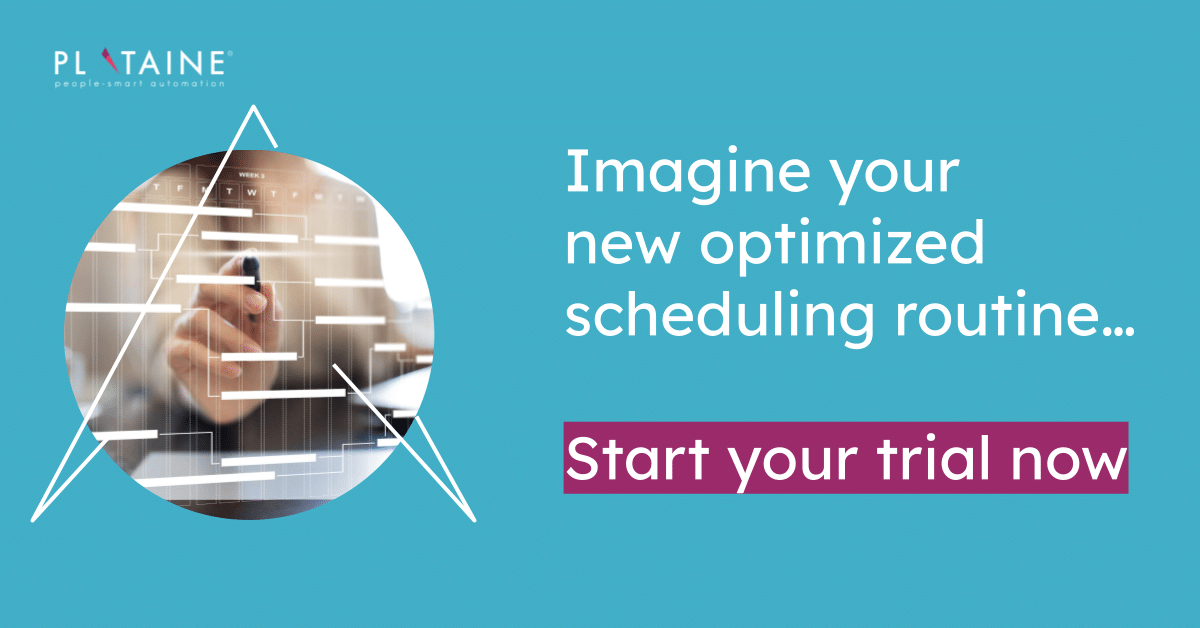When it comes to production planning and scheduling, many manufacturers in fields such as aerospace, automotive, wind etc. turn to what they know best: spreadsheets. Excel has been a long-time friend of businesses, offering a familiar grid-like interface where production schedules can be plotted out with the simplicity of rows, columns and easy calculation capabilities. But as production capacity grows, and the demand for efficiency skyrockets, is this trusty old Excel spreadsheet still the best tool for the job? Or do your operations cross the limit of what Excel can handle. For most manufacturing organizations the latter is true, and the time has come to switch to more specialized production scheduling software. Let’s dive in and compare.
What Makes Excel spreadsheets a Common Tool for Production Planning and Scheduling?
Excel’s ubiquity in the workplace is no accident, its interface is almost second nature to most professionals, making it the default choice for a multitude of organizational tasks. One of Excel’s prime advantages is the sheer flexibility of spreadsheets—they are the Swiss Army knife of data manipulation, enabling users to slice, dice, and format their schedules to their liking. You can adjust timeframes, add tasks with a few keystrokes or mouse clicks, giving users a sense of direct and immediate control over their planning documents.
Moreover, Excel’s cost-effectiveness cannot be overstated. For most businesses, Excel is part of the Microsoft Office suite that’s typically included with their computers. This means that many companies don’t have to spend extra on specialized software for their basic scheduling needs.
Despite these advantages, Excel’s limitations become apparent when faced with the intricate dance of modern production scheduling. For starters, the simplicity that makes Excel so accessible is also its Achilles’ heel when dealing with the sophisticated demands of production environments, where variables such as machine availability, workforce shifts, maintenance windows, and supply chain logistics intertwine. Excel doesn’t natively account for these complexities and cannot easily alert users to scheduling conflicts or resource over-allocations.
Additionally, Excel’s traditional single-user framework can be a significant barrier to effective team collaboration. In the era of cloud computing and real-time updates, Excel’s file-based system is clunky. When multiple stakeholders from planning and operations need to input data, the ‘last save wins’ approach can lead to a tangle of conflicting file versions, causing confusion and errors. This version control headache is compounded by data integrity concerns, where critical information can be accidentally overwritten or deleted, and changes are hard to track without meticulous manual oversight. This is why the planner is often the only one in control and he doesn’t collaborate with the operators on the factory floor.
In essence, while Excel remains a common scheduling tool, the evolving nature of production planning is highlighting its shortcomings, especially when complexity and scale increase.
Planning and Scheduling Solutions Alternative
We venture into the realm of Advanced Planning and Scheduling (APS) software, which is engineered with the sole purpose of mastering the intricacies of production scheduling. These powerful platforms are tailored to navigate the labyrinth of manufacturing needs, effortlessly managing a multitude of variables that go far beyond the capabilities of a simple spreadsheet.
APS systems are like the conductors of an orchestra, harmonizing various sections—resource allocation, machine maintenance, labor shifts, and delivery timelines—into a cohesive symphony – the weekly plan. They possess the ability to not just process but also analyse vast amounts of data, making real-time adjustments that optimize the flow of production. This includes balancing workloads, predicting potential bottlenecks before they occur, and recalibrating schedules in response to unforeseen disruptions.
But perhaps one of the most groundbreaking features of APS software is its collaborative prowess. In modern manufacturing, collaboration is not just a benefit but a necessity. APS platforms are built from the ground up to support multiple users simultaneously. They enable teams to input, access, and analyze data concurrently, breaking down silos that traditionally existed between departments. This real-time collaboration ensures that when operators report on task completion, the planner can see the impact immediately.
Additionally, the dashboard functionality of APS tools provides a bird’s-eye view of the entire production process. This is where the software truly shines, offering visibility into every corner of the operation. Leaders can monitor machine availability, track workforce allocation, and view inventory levels—all in one place. This centralization of information is a stark contrast to the isolated data islands of Excel spreadsheets. With such integrated systems, decision-makers have a comprehensive understanding of the operation, enabling them to make informed decisions quickly and with confidence.
Benefits of Production Scheduling Software
Real-time Updates: One of the paramount advantages of production scheduling software is its ability to refresh data instantaneously. This means as soon as a change is made—be it in the order queue, the production line, or supply status—it’s reflected across the entire system. This real-time information flow is invaluable for managers who need to make on-the-spot decisions. It eliminates the delays inherent in manual spreadsheet updates, where critical time can be lost just waiting for the latest version of the document.
Complex Processes Handling: Modern manufacturing is a complex beast, with countless moving parts including labor, machinery, materials, and logistics. APS software thrives in such an environment, digesting and processing vast volumes of data that would choke a conventional spreadsheet. It not only stores this data but also allows for sophisticated analysis, helping to identify trends, forecast outcomes, and suggest optimizations, which would be near impossible with Excel without extensive programming.
Collaboration and Communication: APS software breaks down the barriers of isolated data by fostering a collaborative workspace. It acts as a centralized hub where all team members can input and access information. This shared access helps ensure that everyone—from production line workers to upper management—is working with the same information, which is crucial for maintaining unified operations and preventing the confusion that can arise from miscommunication.
Scalability: As a business expands, its processes and systems must grow with it. APS software is designed with scalability in mind, capable of handling an increase in production volume, product lines, or complexity without a hitch. This stands in stark contrast to Excel, which becomes more cumbersome and error-prone as the demands on it grow, often leading to fragmented files and inconsistent data.
Decision Support: Finally, the analytics and reporting capabilities of APS software serve as a cornerstone for strategic decision-making. Managers can leverage these tools to gain insights into the efficiency of production processes, the profitability of product lines, and the performance of suppliers. These analytics can highlight areas for improvement, predict the impact of potential decisions, and ultimately guide the strategic direction of the company with a level of detail and accuracy that Excel cannot match.
Furthermore, the planner can quickly simulate and run “what if” scenarios, for example, what would be the impact of adding a shift or a certain resource, such as a tool etc.
Tips for Quick and Smooth Implementation of Production Scheduling Software
Define Your Needs: Before leaping into a new system, it’s essential to map out exactly what you require from your production scheduling software. This means conducting a thorough analysis of where Excel is falling short and identifying the specific functionalities your operation needs. Do you need better resource tracking, more detailed scheduling, or improved forecasting? Understanding these needs upfront will guide you in selecting a software that’s tailored to your unique manufacturing environment and ensures that the new system addresses your specific pain points.
Get Buy-in: Implementing a new system is as much about people as it is about technology. To ensure a successful transition, it’s crucial to have the support of the team who will be using the software. This involves clear communication about the benefits of the new system—how it will make their jobs easier, improve accuracy, and benefit the company overall. Equally important is providing adequate training and resources to ensure that all users feel confident and competent in using the new software.
Start Small: When it comes to implementation, the ‘big bang’ approach can be overwhelming. A more effective strategy is to start small, perhaps by applying the software to a single production line or a particular aspect of your scheduling process. This phased approach allows users to acclimatize to the new system gradually and provides an opportunity to iron out any kinks before a full-scale rollout.
Choose User-Friendly Software: The usability of the new software is a critical factor in its successful adoption. A system that is intuitive and easy to navigate will significantly reduce the learning curve and resistance to change. Look for software with a clear and uncluttered interface, logical workflows, and accessible help resources. The easier the software is to use, the more quickly your team will adapt to it.
Seek Support: Finally, the level of support provided by the software vendor is a vital consideration. No matter how user-friendly the system is, there will always be questions and challenges along the way. Opt for a provider known for its excellent customer support, including comprehensive training materials, responsive customer service, and technical assistance. Good support can make the difference between a frustrating implementation and a smooth transition.
Implementing a new production scheduling system doesn’t have to be a daunting task. By understanding your needs, ensuring user buy-in, starting small, choosing user-friendly software, and seeking strong support, you can make the transition from Excel to an advanced APS tool both successful and relatively painless.
In conclusion, while Excel has served businesses well for many years, the complexity and collaborative nature of modern manufacturing often call for more robust solutions. Production scheduling software offers a level of specialization that can lead to more efficient, error-free scheduling, ultimately saving time and money. If you’re still relying on spreadsheets for your production scheduling, it might be time to consider whether a dedicated APS solution could be a better fit for your needs.










